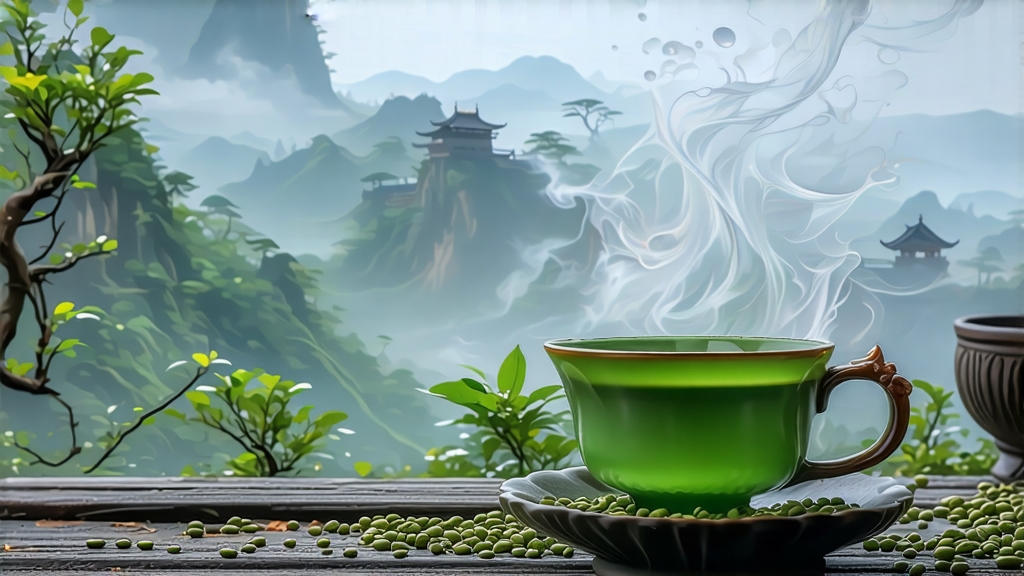
If green tea is the youthful scholar of Chinese teas and pu-erh the venerable sage, then Tie Guan Yin—literally “Iron Goddess of Mercy”—is the poised poet who balances between their worlds. Hailing from the granite ridges of Anxi in southern Fujian, this oolong has, for almost three centuries, seduced emperors, sustained monasteries, and now graces the Instagram feeds of tea bars from Brooklyn to Berlin. Yet behind its jade-leaf glamour lies a saga of soil, craft, and devotion that few casual sippers ever fully taste. This essay invites you into that saga: the mythic birth, the bewildering styles, the sweat-soaked craft, and the quiet ritual that turns a crumpled leaf into what Chinese connoisseurs call “living iron.”
-
The Legend: When Guanyin Whispered to a Farmer
Local lore sets the story in the 1720s. A poor farmer named Wei Yin, devout to the Bodhisattva Guanyin, found a withered iron statue of the goddess in a forgotten shrine. After polishing it daily and offering incense, he dreamed one night that the statue pointed him to a cave behind his hut. There, a single tea shrub glistened with dew. He transplanted it to his garden, and the tea it yielded was so fragrant that neighbors claimed it carried the compassion of Guanyin herself. Wei shared cuttings; the cultivar spread across Anxi’s rocky valleys, acquiring the name Tie Guan Yin—“Iron” for its heavy, lustrous leaves, “Goddess of Mercy” for the dream that delivered it. Historians now place the cultivar’s domestication closer to the late Ming, but the myth still shapes every leaf: farmers speak of “Guanyin’s breath” when the aroma drifts across the cooling trays. -
Terroir: Granite, Mist, and the Taste of “Yun”
Anxi County rises 600–1,200 m above sea-level, its peaks wrapped in cloud nine months of the year. The soil is lateritic granite, acidic and fast-draining, forcing roots to struggle and concentrate aromatic compounds. Diurnal swings of 10 °C slow the conversion of catechins to tannins, gifting Tie Guan Yin its signature minerality—locally dubbed yun, a word that collapses “resonance,” “aftertone,” and “lingering throat-cool” into three letters. Eight micro-valleys, each with its own humidity curve, yield eight stylistic substyles, but all carry a whisper of wet stone and orchid. -
Cultivars: Beyond the Original Goddess
While the original Hongxin (“red-heart”) Tie Guan Yin remains the genetic aristocrat, clonal selections have emerged. Waiwei RTP-12 offers higher yield but thinner yun; Jinxuan (TTES #12) sacrifices orchid for milk-cream notes; the newer “Golden Tie Guan Yin” is a cross with Huangjin Gui, engineered for jasmine-like top notes. Purists insist only Hongxin grown within the 24 villages of Gande, Xiping, and Longjuan can bear the name, much like Champagne in France. Yet diaspora gardens in Taiwan, Thailand, and even Malawi now craft their own “TGY,” forcing Anxi to protect its geographic indication with QR-coded traceability stickers. -
Craft: The Green-Blue Alchemy
Tie Guan Yin is the most labor-intensive Chinese tea, requiring 24–36 hours of uninterrupted human judgment. After dawn plucking of the “open-face” leaf—three leaves and a bud—comes sun-withering for 30–45 minutes, just until the edges feel like parchment. Indoor cooling on bamboo trays follows, where leaf temperature drops to 22 °C, triggering grassy volatiles. Then the master’s hands intervene: tossing in a 45 °C tumble-dryer bruises the margins while keeping the veins intact. This partial rupture oxidizes only 20–30 % of the leaf, the narrow band that turns jade into emerald. A 2–3 minute kill-green at 280 °C locks the color, followed by rolling into the iconic “dragonfly head, toad tail” shape. The final charcoal bake, once done with longan wood, is now often electric, yet the best lots still endure three low-temperature firings over 40 days, each lowering moisture by 2 % and adding a whisper of smoked orchid. -
Styles: From “Green Goddess” to “Deep